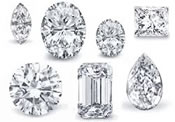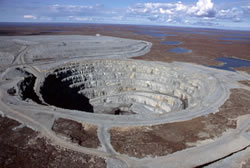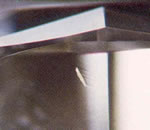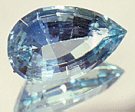In December we launched a new web site www.DiamondSourceVA.com so that our clients could have access to more information about diamonds and diamond shopping. The new format allows us to add more pages and updated information quicker and we hope you find it easy to use.
This is the first edition of our Newsletter in an improved format that is available in either HTML or plain text versions. There is a lot happening in the diamond industry and we will be bringing you news and educational highlights.
Visit www.DiamondSourceVA.com
WEB SITE HIGHLIGHTS: JEWELRY INSURANCE
We encourage you explore our new web site to learn more about diamonds and the diamond industry. Getting your diamonds and jewelry properly insured is an important step for long term happiness.
Learn more about jewelry insurance
DIAMOND SHOPPER MISTAKES: START WITH RIGHT SHAPE
Beginning with this issue of the newsletter, we are highlighting common mistakes diamond shopper make. We hope these comments will assist future shoppers make a better educated diamond purchase decision.
 WRONG SHAPE – While more a more gals are involved in the shopping process for their engagement or anniversary diamond, there are still many guys who are attempting to surprise her. We find that girls usually have a favorite shape but more importantly they have shapes they definitely do not like. The biggest mistake a guy can make is to get the one shape she hates just because it happens to be the one he likes. Almost every week we get an email with words like “she wants a round diamond but I am going to get her a marquise because I like that best.” Starting a relationship by ignoring her wishes does not bode well for a future of love and sharing.
WRONG SHAPE – While more a more gals are involved in the shopping process for their engagement or anniversary diamond, there are still many guys who are attempting to surprise her. We find that girls usually have a favorite shape but more importantly they have shapes they definitely do not like. The biggest mistake a guy can make is to get the one shape she hates just because it happens to be the one he likes. Almost every week we get an email with words like “she wants a round diamond but I am going to get her a marquise because I like that best.” Starting a relationship by ignoring her wishes does not bode well for a future of love and sharing.
We encourage guys to try to get some feedback on the shape she wants even when the presentation is going to be a surprise. If you are at a point in a relationship where you are thinking of proposing, it seems like a trip to a jewelry store to try some rings on is not out of the question, especially if it is done months before you are thinking of purchasing.
Some gals contribute to the guys challenge by saying “I want to be surprised so I will be happy with whatever you give me.” Even if you feel that way, we think it would be nice if the gal at least give a list of shape choices she would be happy with.
In the end, if the guy has no idea of what shape she would like the best, we always recommend the round diamond. It is the most popular and the brightest of the shapes plus it is the most versatile in terms of what you can do with it in the future. Not many gals hate a round diamond so it is the safest for that total surprise.
Discover more shopping advice secrets
DIAMOND PRODUCERS
Africa continues to be the main producer of rough diamonds, although several other places are quickly catching up. The African nation of Botswana is the world’s largest producer at this time with an expected production of over 24 million carats of diamonds.
Russia, which is right behind Botswana in production of rough diamonds mines about 20 million carats annually and continues to grow production. Most of the Russian diamonds are produced in the frigid Northeast areas close to Siberia. Russia could well out-produce Africa in the coming years as their economy becomes more efficient.
 At the end of 2003, Canada was the world’s third-largest producer of diamonds, providing 15% of the world’s supply. The top two diamond producers are Botswana and Russia. Canada’s quest for diamonds looks like one of the biggest stories in Canada for the next 10 to 20 years and beyond.
At the end of 2003, Canada was the world’s third-largest producer of diamonds, providing 15% of the world’s supply. The top two diamond producers are Botswana and Russia. Canada’s quest for diamonds looks like one of the biggest stories in Canada for the next 10 to 20 years and beyond.
Australia is the largest producer of rough diamonds as far as weight with over 26 million carats per year. But many are off colors. But this is a good thing since Australia is the world’s largest producer of rare pink diamonds. Based on the average production, Australia will be producing gem quality diamonds for many decades to come from the Western Australian province.
Most people do not realize that from around 1835 until the African diamond discoveries in the late 1880’s, Brazil was the world’s largest producer of diamonds. When you look at a pre-historic world map when all of the continents were joined, the diamond producing areas of Brazil were joined to the diamond producing areas of Africa. So it’s no wonder that Brazil is a major producer of diamonds, since it is geologically connected to the diamond producing fields in Africa. Brazil is still a major producer of rough diamonds averaging around 650,000 carats of rough annually.
AGS WEB SITE
The American Gem Society Laboratories (AGSL) upgraded its Web site at www.agslab.com with a new look and a focus on both the consumer and the trade. Founded in 1996, AGS Laboratories is one the leading diamond grading laboratories in the jewelry industry. The laboratory issues the Diamond Quality Document, the first and only report to ever grade on diamond cut.
To view the site, visit www.agslab.com
INCLUSIONS & BLEMISHES: CAVITY
Cavities are openings on the surface of a diamond. They may be caused by cleavage, by a blow, but generally are created when an included crystal is “pulled out” from the surface during polishing. A cavity is as the name implies a cavity, a void, a bubble or a lack of crystallization in the stone. The location can be an any part of the stone.
 It is sometimes very difficult to differentiate between a chip, natural or cavity. Under high magnification, a cavity can often be identified because minute diamond fragments were broken away from the leading edge of the cavity by the polishing wheel, which were then drawn across the cavity to the opposite diamond surface. These “drag marks” on one side of a cavity are the sign that material was moved from that spot. A cavity is like a pit in the surface of the diamond extending into the diamond. It can be as small as a needlepoint in the surface or a large hole big enough for a match head. Cavities are not dangerous or necessarily bad. While cavities have no color, if big enough they can collect dirt and become more visible. Like all other inclusions, the significance of a cavity depends on its location, its size and how visible it is to the naked eye and under 10x magnification.
It is sometimes very difficult to differentiate between a chip, natural or cavity. Under high magnification, a cavity can often be identified because minute diamond fragments were broken away from the leading edge of the cavity by the polishing wheel, which were then drawn across the cavity to the opposite diamond surface. These “drag marks” on one side of a cavity are the sign that material was moved from that spot. A cavity is like a pit in the surface of the diamond extending into the diamond. It can be as small as a needlepoint in the surface or a large hole big enough for a match head. Cavities are not dangerous or necessarily bad. While cavities have no color, if big enough they can collect dirt and become more visible. Like all other inclusions, the significance of a cavity depends on its location, its size and how visible it is to the naked eye and under 10x magnification.
PLANETS OF DIAMONDS
Some planets in our galaxy could harbour an unexpected treasure: a thick layer of diamonds hiding under the surface.
No diamond planet exists in our solar system, but some planets orbiting other stars in the Milky Way might have enough carbon to produce a diamond layer, Princeton University astronomer Marc Kuchner said recently.
That kind of planet would have to develop differently from Earth, Mars and Venus, so-called silicate planets made up mostly of silicon-oxygen compounds.
Carbon planets might form more like some meteorites than like Earth, which is believed to have condensed from a disk of gas orbiting the sun.
In gas with extra carbon or too little oxygen, carbon compounds like carbides and graphite could form instead of silicates, Kuchner said at a conference on extrasolar planets in Aspen, Colorado.
Any condensed graphite would change into diamond under the high pressures inside carbon planets, potentially forming diamond layers inside the planets many kilometres thick.
Carbon planets would be made mostly of carbides, although they might have iron cores and atmospheres. Carbides are a kind of ceramic used to line the cylinders of motorcycle engines among other things, Kuchner said. Planets orbiting the pulsar PSR 1257+12 may be carbon planets, possibly forming from the disruption of a star that produced carbon as it aged, he said.
Other good candidates for carbon planets might be those located near the galaxy’s centre, where stars have more carbon than the sun. In fact, the galaxy as a whole is becoming richer in carbon as it gets older, raising the possibility all planets in the future may be carbon planets, Kuchner said.
GEMSTONES: AQUAMARINE
 Aquamarine, named for the Latin phrase “water of the sea”, is a blue to blue-green variety of the mineral beryl. Beryl also contains other gem varieties, including emerald and some lesser known varieties (such as morganite and heliodor). Light green beryl can be transformed into aquamarine if heated to 750º F (400º C). The green hues in regular aquamarine can also be removed through heating. In fact, almost all aquamarine gems on the market today are heat-treated. Generally, the deeper the blue color in aquamarine the greater its value. A very dark form of beryl resembling deep blue sapphire is artificially formed by irradiating certain beryl. These dark blue stones are not called aquamarine but “blue beryl”.
Aquamarine, named for the Latin phrase “water of the sea”, is a blue to blue-green variety of the mineral beryl. Beryl also contains other gem varieties, including emerald and some lesser known varieties (such as morganite and heliodor). Light green beryl can be transformed into aquamarine if heated to 750º F (400º C). The green hues in regular aquamarine can also be removed through heating. In fact, almost all aquamarine gems on the market today are heat-treated. Generally, the deeper the blue color in aquamarine the greater its value. A very dark form of beryl resembling deep blue sapphire is artificially formed by irradiating certain beryl. These dark blue stones are not called aquamarine but “blue beryl”.
Aquamarine is a fairly common gem, and is thus affordable. Some enormous transparent crystal masses have been exploited, and exquisite gems weighing thousands of carats have been cut from them. The beautiful light blue to blue-green color of aquamarine may fade upon prolonged exposure to light, so it is especially important to purchase this gem from a reliable dealer.
Light blue topaz is easily mistaken for aquamarine. The colors of these two gems are identical, and their physical properties are very similar. Topaz is the less expensive gem, and some crooked dealers may sell their topaz as aquamarine.
Unlike emerald, aquamarine gems are often completely flawless. In fact, an aquamarine gem with a visible flaw is rarely seen. The costs of producing synthetic aquamarine are very high when compared to the relative abundance of this gem, so synthetic aquamarine is not available on the market. However, production of synthetic blue spinel is easy and inexpensive, so it is used as a cheap aquamarine simulant. It is often mistakenly sold as “Synthetic Aquamarine”.
Aquamarine is a hard and durable gem, but occasionally develops internal cracks if banged hard. Its color may fade upon prolonged exposure to light.
Aquamarine is faceted into many cuts. It is used in jewelry for rings, earrings, necklaces, etc. Many large, flawless gem pieces have been cut. Occasionally, perfect, flawless, six-sided crystals are worn as necklace pendants. Translucent aquamarine displaying a cat’s eye effect and asterism are cut and polished into cabochons.
